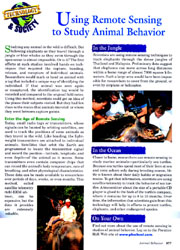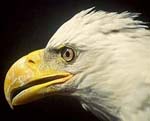.
Click
for a full size copy of page 877 of the Dragonfly Book, where this
work is discussed.
.
E-mail
from Eagles?
Click on the Photo to find out more.xx
Web
Resources on This Topic:
Laboratory
for Applied Biotelemetry & Biotechnology at Texas
A&M University, Galveston
This excellent site, maintained by the Department of Marine Biology,
describes how remote sensing technology (also called biotelemetry)
is used to study the biology of wide-ranging endangered or threatened
species, and species whose habits make them difficult to study.
Don’t let scientific jargon in the titles of some links scare
you off. Explore this site and see the fascinating work they are
doing.
Operation
Crane Watch (United States Geological Survey)
This great site focuses on studies of sandhill cranes that range
across the central US and winter from Texas and eastern New Mexico
south to central Mexico. The research is attempting to describe
their migration patterns, and to determine where these birds breed
in Canada, Alaska, and northeastern Siberia.
The
Santa Cruz Predatory Bird Research Group: Migration Studies
(Long Marine Lab, University of California, Santa Cruz)
A fascinating site, focused on studies of migration and foraging
habits of Bald Eagles and other predatory birds, with an eye towards
conserving habitats essential to safeguard these magnificent animals.
Porcupine
Caribou Herd Satellite Tracking Project
This site is operated by a consortium of wildlife agencies using
satellite tracking to study seasonal range use and migration patterns
of the Porcupine Caribou herd in northern Yukon, Alaska and NWT.
Whale
Net (Wheelock College, Boston)
This attractive, user-friendly site for teachers and students
focuses largely on whale research, including tracking of individuals
through vast stretches of ocean. Check it out!
H.A.B.I.T.
Research: wildlife tracking and telemetry equipment
This site is operated by a company that produces several
kinds of instruments used in biotelemetry studies. Check out the
link labeled "Photo Album" for an idea of how their
devices are used in a variety of research projects. (Note: this
commercial site is included for informational purposes only; its
inclusion does not indicate endorsement of this company, its approach,
or its products.)
Mini
Mitter: Physiological and Behavioral monitoring for
Animals and Humans
This site is included to emphasize that many areas of biological
research, along with technologies they use, are interconnected.
Some of the same sorts of devices used in studies of free-ranging
animals are also used to gather medically important information
from human patients who (because of their own behavioral preferences)
prefer to be monitored without being tied to a bed by hard-wired
electronic gear! (Note: this commercial site is
included for informational purposes only; its inclusion does not
indicate endorsement of this company, its approach, or its products.)
The
Association for the Study of Animal Behaviour
The spelling of the word "behaviour" tells you that
this society is based in Great Britain; its site offers some interesting
windows onto the range of studies ongoing in animal behavior.
|
. Click for a full size copy of page 877 of the Dragonfly Book, where this work is discussed. . E-mail
from Eagles? |
|
(A web site developed by Ken Miller and Joe Levine to provide scientific and education support for teachers and students using our textbooks)


